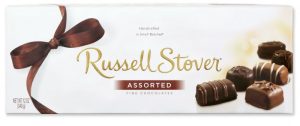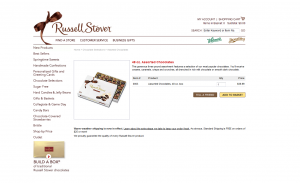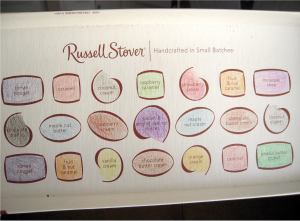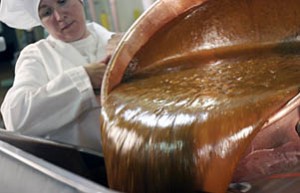 People seem to be throwing chocolates at me as gifts these days. Maybe it’s a sign that I’m getting old and people are running out of gift ideas. Whatever the reason, I knew that getting fat was inevitable. While I was gaining pounds, I figured I might as well get some intellectual benefit by writing critiques.
People seem to be throwing chocolates at me as gifts these days. Maybe it’s a sign that I’m getting old and people are running out of gift ideas. Whatever the reason, I knew that getting fat was inevitable. While I was gaining pounds, I figured I might as well get some intellectual benefit by writing critiques.
One of my recent gifts was a box of Russell Stover assorted chocolates. Throughout my life, I have been gifted with more Russell Stover chocolate products than any other brand. I figured there must be a reason for that, so I began my investigation.
Reasons for Commercial Success
Did you know that Russell Stover Candies is the third largest manufacturer of chocolates in the US? (Mars is #1 and Hershey is #2.) This fact is surprising when you consider that Mars and Hershey are global public corporations, whereas Russell Stover Candies is a private family-owned company. It is also a bit confusing when you realize that Mondelez earns nearly twice what Hershey makes on net confection sales, yet Mondelez is not in the top 3 chocolate manufacturers in the US. Ignore that for now.
Russell Stover Candies boasts some $600 million in annual sales. The company is smart to differentiate their chocolate products from the individually-wrapped chocolate bars of Hershey and Mars. In fact, Russell Stover dominates in the distribution of boxed chocolates in America. Nearly every drugstore and grocery store carries Russell Stover products, and their holiday gift boxes are iconic.
Indeed, much of Russell Stover’s success has been attributed to its packaging—not its chocolates. The iconic Valentine’s Day heart-shaped box has helped the company dominate V-day chocolate sales.
You’ll find a few different brands of boxed chocolates at the store. My personal favorite is Guylian chocolates, though these aren’t nearly as popular or abundant as Russell Stover’s products. I recently bought a box of Maxfield’s, but that’s a local brand. No boxed chocolate products are as copious as Russell Stover. The only real competitor I could think of was Whitman’s—until I realized that was just another Russell Stover brand. (Whitman’s was the original boxed chocolate brand in America. Russell Stover Candies acquired Whitman’s in 1993.)
Russell Stover products are often put in a category called “bag / bar / boxed chocolate”. In 2011, this industry grew 23.2% and has maintained a “moderate” rate of growth ever since.
Since Russell Stover Candies is a private business, it was difficult to find much data to help me understand how their products have been so commercially successful. I did find a website where I could purchase reports on the chocolate industry as a whole, but I didn’t feel the need to buy them at this time. You can check that out here if you’d like to learn more.
My Personal Reaction to Russell Stover Chocolates

So all that research is great, but I know you’re more interested in what I think about the brand. There are things I love and things I don’t love as much about the Russell Stover brand of Russell Stover Candies.
What I love
- Their classic & easily-recognizable logo
- The simple, elegant minimalist design on their chocolate boxes
- The variety of flavors they have developed
- The arrangement of chocolates in the box
- The minimalist white & brown design of their website
- How you can “build a box” on their site; fill a box with your favorite flavors

One thing Russell Stover pulls off well is the simplicity in all its branding. Their website is as simple as can be, yet still attractive. I like the white background on their assorted gift boxes. It complements the brown and gold typeface quite well.
Another well-designed element is the layout of chocolates in the gift box. First of all, Russell Stover does have a decent selection of unique chocolates in its gift boxes. To take this one step further, even the redundant flavors are strategically positioned in the gift boxes so as to lead the consumer to believe that there is an greater combination of flavors than what is actually there. As my colors illustrate in this photograph, this layout attempts to dazzle consumers into feeling blessed with a larger selection of chocolates. The swirly illustrations also give just a touch of the artisan feel.
What I Don’t Love
Their chocolates are decent, but they don’t wow me. They are branded as “fine chocolates”, and they certainly exhibit a higher level of craftsmanship than the mass-produced chocolates of Mars and Hershey. But they don’t taste as delicate as See’s Candies. The creamy chocolates aren’t as luxurious as Belgian chocolates or other creamy chocolates you could purchase in specialty chocolate shops. These are certainly not the finest chocolates you can get.
However, Russell Stover products are about as fine as you can expect at such a low price. In fact, Co-Founder Martin Christy of the International Chocolate Awards explains that their products are in the “affordable premium” category of chocolates. Evidently, the demand for affordable premium products in the US is enormous.
Perhaps my biggest qualm with Russell Stover is the slogan, “Handcrafted in Small Batches”, followed by the Registered Trademark symbol. The “letter” from Co-Owner Tom Ward on the back of the box says they use copper kettles and kitchen mixers.

With all the research I have done, I can’t find much to support this claim. All reputable sources cite Russell Stover Candies as a “manufacturer”. I read reviews about the company from current and former “factory workers”. All signs point to mass-production.
The long list of artificial ingredients on the back of the box doesn’t inspire much confidence either. At this point, the most compelling case I have found for validating the “Handcrafted in Small Batches” claim is this:
“The friendly Russell Stover representative I spoke to said that they actually do make their chocolate in smaller batches than other chocolate companies (which doesn’t necessarily say much and which is still far from a kindly grandma making each chocolate by hand); she said that they aren’t technically “mass-produced” like other chocolates. In addition, she said there is more human interaction between each step—workers check at regular intervals to approve of the quality. She added that this means the chocolate doesn’t start in a vat and move from machine to machine to machine until it’s spit out on a conveyor belt and packaged.”
A search for images of the “Russell Stover factory” yields sparse and unsatisfying results. There are many bloggers who have criticized the “Handcrafted in Small Batches” claim. There may be some truth behind it, but the claim gives me a level of cognitive dissonance. The issue remains unresolved.
Wrapping It Up—But Not Literally
Russell Stover Candies boasts an impressive history of dominating the boxed chocolate niche. Its focus on developing affordable premium products has secured its #1 spot in the boxed chocolate industry for decades. As far as I can see, it will continue to do so for years to come.